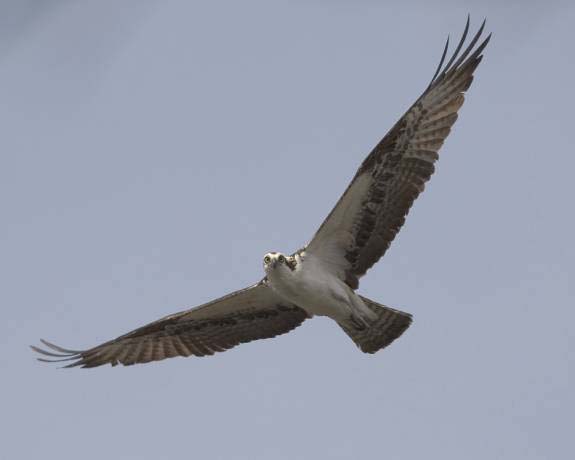
Raptor Identification - Osprey

If you have any photos of Osprey that you would like to contribute, please e-mail them to us with a caption and the photographer's name (but be aware that we must be selective of which photos we include because of space limitations for our website). |
Click on each photo for a description and a bigger picture
 |
 |
||
 |
 |
||
 |
 |
||
 |
 |
||
 |
 |
||
 |
 |
The following article about Ospreys was reproduced (with modifications) from the November 2000 issue of CPF's Talon Tales. The article was written by Marcel Gahbauer.
|
One of Canada’s largest raptors, the osprey (Pandion haliaetus) is a fascinating predator. Its English name is actually a misnomer, as it comes from the Latin Ossifraga, meaning bone-breaker, and would have been a better fit for the largely unrelated European lammergeier (or bearded vulture) which is renowned for dropping bones on rocks to access the marrow within. The osprey’s scientific species name, haliaetus, is somewhat more appropriate as it means "sea eagle" in Greek. Despite often being thought of as an eagle, the osprey is in fact considered to be in a family of its own.
In flight, the osprey has a distinctive silhouette, holding the wrist above the rest of the wing. From below, a dark patch of feathers is visible near the wrist, which contrasts against the otherwise white underwings. The tail is strongly barred in adults, and has a wide white band near the tip in juveniles. At a distance, a flying osprey can be mistaken for a gull due to the shape and position of its wings, but at closer range the wrist patch and tail patterns are diagnostic. Because of its large size, whitish head, and similar choice of habitats, the osprey is also often mistaken for an adult bald eagle, but even at a considerable distance, the osprey can be recognized by its white underparts. Natural history: Most North American ospreys are highly migratory, and spend winter either on mainland Central or South America, or on Caribbean islands. In eastern North America, the peak of fall migration is usually around mid-September; the spring migration is less concentrated, with individuals returning to territories between March and mid-May. Interestingly, after their first fall migration, most young ospreys stay in the south for a year and a half before heading back to North America. Upon returning, they may begin to search for potential territories, but usually will not breed until they are at least three years old. Territory size appears to be directly related to food abundance. Where fish are plentiful, ospreys may nest as little as 20 metres apart in loose colonies; but where resources are more limited, especially at the northern extremes of their range, the territory of a single pair may be as large as 200 km2 (75 sq. miles). Although nests are typically built in old trees, ospreys are highly adaptable and have used everything from cacti to active power transmission poles - what remains consistent is that nests are almost always over or very near water. Nests are made mostly of sticks, brought to the nest by the male and arranged by the female. Pairs return to the same nest annually, and add to it each spring. Osprey eggs are a creamy white to tan colour with deep red or chestnut blotches, and have been described as the most attractive among all raptors. Most clutches contain two to four eggs, and incubation lasts 35 to 43 days. The female remains at the nest until the nestlings are almost one month old, with the male doing all the hunting during this time. Chicks fledge around 52 or 53 days of age, and remain dependent on their parents for food for at least a further six weeks. Conservation: Despite these pressures on the population, osprey numbers in most parts of Canada have been increasing markedly in recent years, in large part thanks to the availability of safe nesting platforms provided by groups such as the Georgian Bay Osprey Society. As awareness of the osprey’s needs continues to grow, and further attempts are made to protect and assist the species, the growth of this remarkable raptor’s population should continue.
|
© Canadian Peregrine Foundation